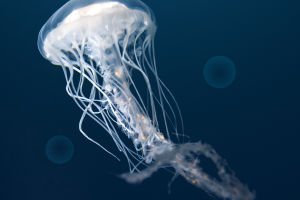The jellyfish body is shaped like a transparent umbrella, and the umbrella body has a large or small diameter.
They can be found in tropical waters, temperate waters, shallow waters, oceans about a hundred meters deep, and even freshwater areas. Jellyfish have been around since 650 million years ago, even before the dinosaurs.
There are more than 250 species of jellyfish in the world's waters, and they are found all over the world. All live in the oceans.
The umbrella of common jellyfish is not very large, only 20-30 cm long, while the umbrella of large jellyfish can be up to 2 meters in diameter. Some of the tentacles can be as long as 20-30 meters, equivalent to the length of a large whale.
Jellyfish floating in the water extend their long tentacles in all directions, and some of them have umbrella-shaped bodies with various color patterns. In the blue ocean, these swimming elves of different colors look very beautiful.
The jellyfish has a special gland inside its umbrella that emits carbon monoxide, which makes the umbrella expand.
In the middle of the jellyfish's tentacles, there is a small ball with a small hearing stone, which is the jellyfish's "ear".
The infrasonic sound waves generated by the waves and air friction impact the hearing stone, stimulating the surrounding nerve receptors, so that the jellyfish can get information a dozen hours before the storm, and disappear from the surface all at once.
Scientists have simulated the jellyfish's sound-transmitting organ to do experiments, and found that the information of ocean storms can be measured 15 hours before.
The body of jellyfish is also divided into upper and lower umbrella surfaces, without a marginal membrane, and the umbrella edge has a ring of tentacles.
The number of tentacles varies among species, and the tentacles are either solid or hollow, long or short, and there are a few species without tentacles.
The umbrella margin has sensory organs, also called tentacle sacs, and the number is 4 or multiples of 4. Sea moon jellyfish have 8, which are notched, thus dividing the umbrella margin into 8 pieces.
The end of the pendant lip in the center of the lower umbrella extends outward to form four or eight mouth carapaces, which are grooved on the side toward the center.
Although jellyfish look beautiful and docile, they are actually very fierce.
Because jellyfish have no respiratory organs or circulatory system and only primitive digestive organs, captured food is immediately digested and absorbed in the cavity.
Once a jellyfish encounters its prey, it never lets go easily.
But just like the rhinoceros and the small birds that clean up its parasites, jellyfish also have their own symbiotic partners.
It is a kind of twin-finned pompano, commonly known as the small shepherd-fish, which is only 7 cm long and can swim between the tentacles of the jellyfish at will, but is not afraid at all.
When a large fish swims in, the small herding fish swims to the middle of the tentacles under the giant umbrella as a safe refuge, using the jellyfish stinging cell device, cleverly avoiding the attack of the enemy.
The jellyfish is shaped exactly like a condensation, it is reddish-purple in color and has no mouth or eyes.
It has objects under its belly on which shrimps attach themselves to swallow saliva. Most of them live for a few weeks or months, but some live for a year or so, and some deep-sea jellyfish can live longer.
Do you know anything about the jellyfish right now?


